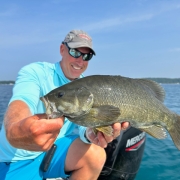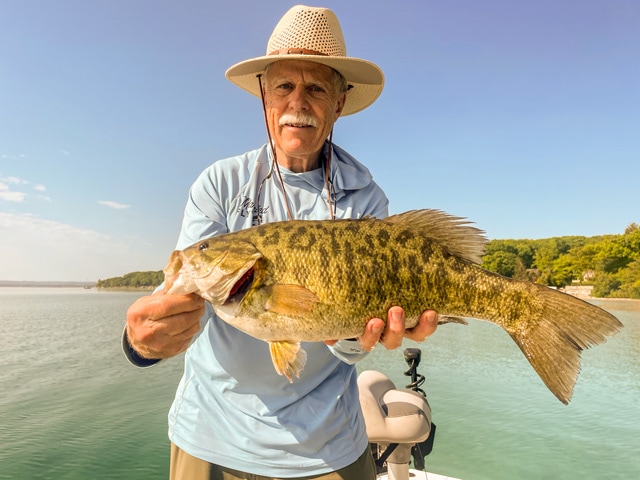Northern Michigan Smallmouth Bass
Northern Michigan Smallmouth Bass

Capt Owen of Clear Water Angling
Smallmouth bass fishing season in Northern Michigan for Mangled Fly guides is in its last few weeks, as we transition towards the Big Manistee and Fall Steelhead But by no means does this indicate that the fishing is slowing down, I highly recommend reaching out to Owen at Clear Water Angling if you have the smallmouth itch this fall. As fall is a prime time to hunt some of the biggest fish of the season, as they put on the feed bag before winter.
Baitfish
One of the key indicators of the fall transition is when you find big Baitfish concentrations. Baitfish are grouping up in huge baitfish balls, and predator fish take advantage. Yesterday on Grand Traverse Bay when we found the bait we found not all smallmouth, but Cisco and even a King Salmon feeding on the baitfish.
 While Grand Travese bay is still in the upper 60’s for tempature as of mid September, which has kept most of the Smallmouth out deep, it is only a matter of time before Baitfish and Smallmouth go shallow.
While Grand Travese bay is still in the upper 60’s for tempature as of mid September, which has kept most of the Smallmouth out deep, it is only a matter of time before Baitfish and Smallmouth go shallow.
When they go shallow throwing A-rigs, or jig and a minnow type outfitters will serve you real well, currently with them hanging on the deeper edges drop shot is the name of the game.
Fishing Drop Shot
Fishing with a drop shot rig for smallmouth bass during the summer months has beeen highly effective for a number of reasons. Smallmouth bass tend to be more active and aggressive during the warmer months, making them more likely to strike at a bait presented in a drop shot rig. The drop shot rig allows for precise presentation of the bait at different depths, which is crucial when targeting smallmouth bass in the late summer as they may be holding at varying depths depending on water temperature and oxygen levels.
Additionally, the drop shot rig is a finesse technique that allows for a subtle and natural presentation of the bait, which can be particularly enticing to wary smallmouth bass in clear water conditions. This can be especially beneficial during the summer when bass may be more selective in their feeding habits. Overall, fishing with a drop shot rig for smallmouth bass during the summer months can increase your chances of success and help you catch more fish.
Some of my favorite late summer finesse baits to fish on a drop shot are Baby Z Too (Arkansa Shiner) KVD Dream Shot (KVD Magic) , and Roboworm 4.5″ (Aarons Magic)
Booking a Smallmouth Trip
Interested in booking a Smallmouth Bass Trip or going for Lake Trout on light tackle, drop us a message via email, or text/call us directly 231-631-5701.
Jon Ray









